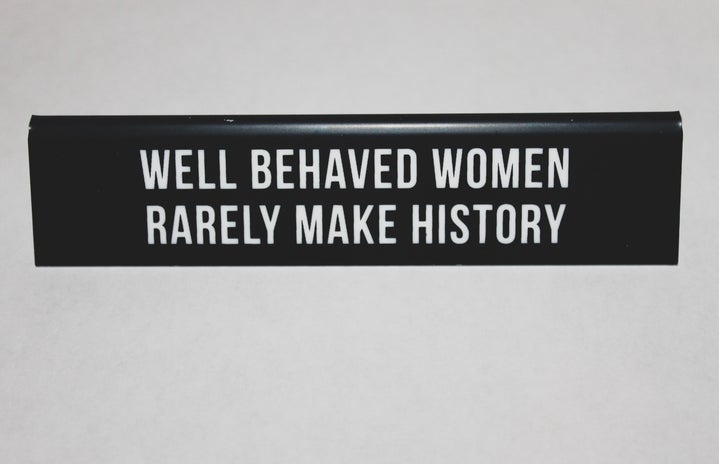Women of the world took to the streets Saturday, marching in protest of the presidential inauguration. With a turnout nearing 5 million people, the Women’s March on Washington is one of the largest protests in history.
There were 672 “sister marches”, protesting in solidarity with the Women’s March on Washington. The marches took place globally and estimated turnouts were overwhelmingly surpassed.
The march was organized in response to themes of racism, sexism, ableism and xenophobia exhibited throughout the 2016 presidential election.
The title “Women’s March on Washington” was inspired by Martin Luther King’s 1963 March on Washington, with the blessing of his daughter, Bernice King.
The women who organized the Women’s March on Washington decided to center the focus of the march on women’s issues from an intersectional standpoint to defend the rights of people who have felt victimized by the hateful ideology brought on by the rhetoric used in the recent election.
Key speakers at the march included Angela Davis, Janet Mock and Gloria Steinem.
Davis is an activist, educator, scholar and politician, known for her radical focus on civil rights. Mock is a TV host and transgender rights advocate whose memoir, “Redefining Realness”, debuted on the New York Times bestsellers list in 2014. Steinem is a writer, political activist and feminist organizer who was the founder of Ms. Magazine and also a co-chair of the march.
Hundreds of signs expressed themes such as love, anger and unity. People of all ages, races and genders were in attendance, chanting and marching peacefully. Washington’s march alone had three times as many people as the presidential inauguration the day before.
St. Paul, MN
What was expected to be 20,000 turned into an estimated 100,000 protesters at the Women’s March Minnesota. People packed the streets, from Cathedral Hill to the State Capitol.
Ilhan Omar, American’s first Somali-American legislator and Minnesota’s newest state representative, spoke about women in government and her reason for marching.
“I am here because I am a woman, but I am also here because I am a black woman,” said Omar. “I am here because I am a muslim woman. I am here because I am a woman who wears a hijab.”
As Omar spoke, applause echoed throughout the crowd surrounding the Capitol. She said, “I am here for women who are queer. I am here for transgender women. I am here for refugees. I am here for young women, I am here for older women. I am here for our girls and for women who are yet to be born.”
After thanking the men in the crowd for marching, she spoke about being raised by her father and grandfather who were feminist men. Omar said, “In order for us to have gender equality and live in a society where there is gender equality, we need the men, the woman and everybody in between.”
Patricia Torres Ray, the first hispanic women to serve Minnesota Senate, spoke about the ratios of women in government and our roles in organizing activism.
“We are powerful my sisters, we are. But we need to continue to strengthen our legacy of organizing,” said Torres Ray. “We need to get more comfortable about organizing and connecting with women who practice different religions, speak different languages and have different legal status.”
Sharon Day spoke in honor of Standing Rock. Congresswoman Betty McCollum spoke in regards to reproductive rights and Planned Parenthood. Ann Reed and K. Raydio headlined the entertainment section of the rally.
Intersectionality was a strong theme among the many speakers and performers at the State Capitol, Saturday.
Critique
Although diversity was deeply embedded in the speeches and organizing of the march, critics of the march challenged the notion that it was entirely inclusive of all women.
One critique was the Pussyhat Project which was a statement in response to the leaked Access Hollywood recording in which President Donald Trump spoke about sexually assaulting women.
The controversy over the hats was that they specifically fit the narrative of white, cis women, ignoring the struggles of trans women and women of color and being adapted as a symbol of this movement.
This sparked online discussion around the topic of “white feminism,” a term that defines a movement or action surrounding the needs of predominantly white women, disregarding other marginalized voices.
One of the protest organizers, Tamika Mallory, spoke on the issue of white feminism in an interview with Vogue.
“It’s discussions that people shy away from. They don’t want to talk about issues of race, of white privilege. It’s, ‘Woo! Why do we have to talk about that?’ There are those, particularly in this movement, who want to have an ‘all women matter’ conversation. Our position is that all women do matter. But black women are particularly suffering. And therefore the black women’s voices will be heard. Not just heard, but leading the charge.”
The global turnout of the marches has been widely televised. With marches on every continent, women and men of all ages and nationalities are standing in the name of unity, with the message that women’s rights are human rights. The conversation being generated in response to the noise of this historic event is sure to go down in history.

